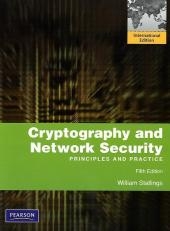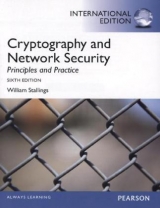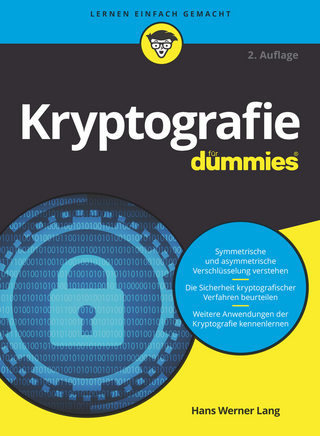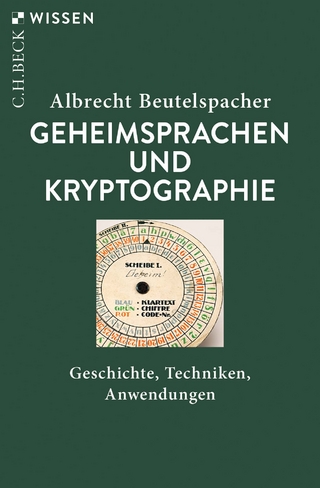
Cryptography and Network Security
Pearson (Verlag)
978-0-13-705632-3 (ISBN)
- Titel erscheint in neuer Auflage
- Artikel merken
In this age of universal electronic connectivity, viruses and hackers, electronic eavesdropping, and electronic fraud, security is paramount. This text provides a practical survey of both the principles and practice of cryptography and network security. First, the basic issues to be addressed by a network security capability are explored through a tutorial and survey of cryptography and network security technology. Then, the practice of network security is explored via practical applications that have been implemented and are in use today. An unparalleled support package for instructors and students ensures a successful teaching and learning experience.
The new edition has been updated to include coverage of the latest topics including expanded coverage of block cipher modes of operation, including authenticated encryption; revised and expanded coverage of AES; expanded coverage of pseudorandom number generation; new coverage of federated identity, HTTPS, Secure Shell (SSH) and wireless network security; completely rewritten and updated coverage of IPsec; and a new chapter on legal and ethical issues.
William Stallings has made a unique contribution to understanding the broad sweep of technical developments in computer networking and computer architecture. He has authored 18 titles, and counting revised editions, a total of 35 books on various aspects of these subjects. In over 20 years in the field, he has been a technical contributor, technical manager, and an executive with several high-technology firms. Currently he is an independent consultant whose clients have included computer and networking manufacturers and customers, software development firms, and leading-edge government research institutions. He has received the prize for best Computer Science and Engineering textbook of the year from the Textbook and Academic Authors Association six times. Bill has designed and implemented both TCP/IP-based and OSI-based protocol suites on a variety of computers and operating systems, ranging from microcomputers to mainframes. As a consultant, he has advised government agencies, computer and software vendors, and major users on the design, selection, and use of networking software and products. Dr. Stallings holds a Ph.D. from M.I.T. in Computer Science and a B.S. from Notre Dame in Electrical Engineering.
NOTATION
PREFACE
Chapter 0 Reader's Guide
0.1 Outline of This Book
0.2 A Roadmap for Readers and Instructors
0.3 Internet and Web Resources
0.4 Standards
Chapter 1 Overview
1.1 Computer Security Concepts
1.2 The OSI Security Architecture
1.3 Security Attacks
1.4 Security Services
1.5 Security Mechanisms
1.6 A Model for Network Security
1.7 Recommended Reading and Web Sites
1.8 Key Terms, Review Questions, and Problems
PART ONE SYMMETRIC CIPHERS
Chapter 2 Classical Encryption Techniques
2.1 Symmetric Cipher Model
2.2 Substitution Techniques
2.3 Transposition Techniques
2.4 Rotor Machines
2.5 Steganography
2.6 Recommended Reading and Web Sites
2.7 Key Terms, Review Questions, and Problems
Chapter 3 Block Ciphers and the Data Encryption Standard
3.1 Block Cipher Principles
3.2 The Data Encryption Standard (DES)
3.3 A DES Example
3.4 The Strength of DES
3.5 Differential and Linear Cryptanalysis
3.6 Block Cipher Design Principles
3.7 Recommended Reading and Web Site
3.8 Key Terms, Review Questions, and Problems
Chapter 4 Basic Concepts in Number Theory and Finite Fields
4.1 Divisibility and the Division Algorithm
4.2 The Euclidean Algorithm
4.3 Modular Arithmetic
4.4 Groups, Rings, and Fields
4.5 Finite Fields of the Form GF(p)
4.6 Polynomial Arithmetic
4.7 Finite Fields of the Form GF(2n)
4.8 Recommended Reading and Web Sites
4.9 Key Terms, Review Questions, and Problems
APPENDIX 4A The Meaning of mod
Chapter 5 Advanced Encryption Standard
5.1 The Origins AES
5.2 AES Structure
5.3 AES Round Functions
5.4 AES Key Expansion
5.5 An AES Example
5.6 AES Implementation
5.7 Recommended Reading and Web Sites
5.8 Key Terms, Review Questions, and Problems
APPENDIX 5A Polynomials with Coefficients in GF(28)
APPENDIX 5B Simplified AES
Chapter 6 Block Cipher Operation
6.1 Multiple Encryption and Triple DES
6.2 Electronic Codebook Mode
6.3 Cipher Block Chaining Mode
6.4 Cipher Feedback Mode
6.5 Output Feedback Mode
6.6 Counter Mode
6.7 XTS Mode for Block-Oriented Storage Devices
6.8 Recommended Web Site
6.9 Key Terms, Review Questions, and Problems
Chapter 7 Pseudorandom Number Generation and Stream Ciphers
7.1 Principles of Pseudorandom Number Generation
7.2 Pseudorandom Number Generators
7.3 Pseudorandom Number Generation Using a Block Cipher
7.4 Stream Ciphers
7.5 RC4
7.6 True Random Numbers
7.7 Recommended Reading
7.8 Key Terms, Review Questions, and Problems
PART TWO ASYMMETRIC CIPHERS
Chapter 8 More Number Theory
8.1 Prime Numbers
8.2 Fermat's and Euler's Theorems
8.3 Testing for Primality
8.4 The Chinese Remainder Theorem
8.5 Discrete Logarithms
8.6 Recommended Reading and Web Sites
8.7 Key Terms, Review Questions, and Problems
Chapter 9 Public-Key Cryptography and RSA
9.1 Principles of Public-Key Cryptosystems
9.2 The RSA Algorithm
9.3 Recommended Reading and Web Sites
9.4 Key Terms, Review Questions, and Problems
Appendix 9A: Proof of the RSA Algorithm
Appendix 9B: The Complexity of Algorithms
Chapter 10 Other Public-Key Cryptosystems
10.1 Diffie-Hellman Key Exchange
10.2 ElGamal Cryptosystem
10.3 Elliptic Curve Arithmetic
10.4 Elliptic Curve Cryptography
10.5 Pseudorandom Number Generation Based on an Asymmetric Cipher
10.6 Recommended Reading and Web Sites
10.7 Key Terms, Review Questions, and Problems
PART THREE CRYPTOGRAPHIC DATA INTEGRITY ALGORITHMS
Chapter 11 Cryptographic Hash Functions
11.1 Applications of Cryptographic Hash Functions
11.2 Two Simple Hash Functions
11.3 Requirements and Security
11.4 Hash Functions Based on Cipher Block Chaining
11.5 Secure Hash Algorithm (SHA)
11.6 SHA-3
11.7 Recommended Reading and Web Sites
11.8 Key Terms, Review Questions, and Problems
Appendix 11A: Mathematical Basis of Birthday Attack
Chapter 12 Message Authentication Codes
12.1 Message Authentication Requirements
12.2 Message Authentication Functions
12.3 Message Authentication Codes
12.4 Security of MACs
12.5 MACs Based on Hash Functions: HMAC
12.6 MACs Based on Block Ciphers: DAA and CMAC
12.7 Authenticated Encryption: CCM and GCM
12.8 Pseudorandom Number Generation using Hash Functions and MACs
12.9 Recommended Reading
12.10 Key Terms, Review Questions, and Problems
Chapter 13 Digital Signatures
13.1 Digital Signatures
13.2 ElGamal Digital Signature Scheme
13.3 Schnorr Digital Signature Scheme
13.4 Digital Signature Standard (DSS)
13.5 Recommended Reading and Web Sites
13.6 Key Terms, Review Questions, and Problems
PART FOUR MUTUAL TRUST
Chapter 14 Key Management and Distribution
14.1 Symmetric Key Distribution Using Symmetric Encryption
14.2 Symmetric Key Distribution Using Asymmetric Encryption
14.3 Distribution of Public Keys
14.4 X.509 Certificates
14.5 Public Key Infrastructure
14.6 Recommended Reading and Web Sites
14.7 Key Terms, Review Questions, and Problems
Chapter 15 User Authentication Protocols
15.1 Remote User Authentication Principles
15.2 Remote User Authentication Using Symmetric Encryption
15.3 Kerberos
15.4 Remote User Authentication Using Asymmetric Encryption
15.5 Federated Identity Management
15.6 Recommended Reading and Web Sites
15.7 Key Terms, Review Questions, and Problems
Appendix 15A: Kerberos Encryption Techniques
PART FIVE NETWORK AND INTERNET SECURITY
Chapter 16 Transport-Level Security
16.1 Web Security Issues
16.2 Secure Sockets Layer (SSL)
16.3 Transport Layer Security (TLS)
16.4 HTTPS
16.5 Secure Shell (SSH)
16.6 Recommended Reading and Web Sites
16.7 Key Terms, Review Questions, and Problems
Chapter 17 Wireless Network Security
17.1 IEEE 802.11 Wireless LAN Overview
17.2 IEEE 802.11i Wireless LAN Security
17.3 Wireless Application Protocol Overview
17.4 Wireless Transport Layer Security
17.5 WAP End-to-End Security
17.6 Recommended Reading and Web Sites
17.7 Key Terms, Review Questions, and Problems
Chapter 18 Electronic Mail Security
18.1 Pretty Good Privacy (PGP)
18.2 S/MIME
18.3 DomainKeys Identified Mail (DKIM)
18.4 Recommended Web Sites
18.5 Key Terms, Review Questions, and Problems
Appendix 18A: Radix-64 Conversion
Chapter 19 IP Security
19.1 IP Security Overview
19.2 IP Security Policy
19.3 Encapsulating Security Payload
19.4 Combining Security Associations
19.5 Internet Key Exchange
19.6 Cryptographic Suites
19.7 Recommended Reading and Web Sites
19.8 Key Terms, Review Questions, and Problems
APPENDICES
Appendix A Projects for Teaching Cryptography and Network Security
A.1 Sage Computer Algebra Projects
A.2 Hacking Project
A.3 Block Cipher Projects
A.4 Laboratory Exercises
A.5 Research Projects
A.6 Programming Projects
A.7 Practical Security Assessments
A.8 Writing Assignments
A.9 Reading/Report Assignments
Appendix B Sage Examples
B.1
Appendix C Sage Problems
C.1
ONLINE CHAPTERS
PART SIX SYSTEM SECURITY
Chapter 20 Intruders
20.1 Intruders
20.2 Intrusion Detection
20.3 Password Management
20.4 Recommended Reading and Web Sites
20.5 Key Terms, Review Questions, and Problems
Appendix 20A The Base-Rate Fallacy
Chapter 21 Malicious Software
21.1 Types of Malicious Software
21.2 Viruses
21.3 Virus Countermeasures
21.4 Worms
21.5 Distributed Denial of Service Attacks
21.6 Recommended Reading and Web Sites
21.7 Key Terms, Review Questions, and Problems
Chapter 22 Firewalls
22.1 The Need for Firewalls
22.2 Firewall Characteristics
22.3 Types of Firewalls
22.4 Firewall Basing
22.5 Firewall Location and Configurations
22.6 Recommended Reading and Web Sites
22.7 Key Terms, Review Questions, and Problems
PART SEVEN LEGAL AND ETHICAL ISSUES
Chapter 23 Legal and Ethical Issues
23.1 Cybercrime and Computer Crime
23.2 Intellectual Property
23.3 Privacy
23.4 Ethical Issues
23.5 Recommended Reading and Web Sites
23.6 Key Terms, Review Questions, and Problems
ONLINE APPENDICES
WilliamStallings.com/Crypto/Crypto5e.html
APPENDIX D Standards and Standards-Setting Organizations
D.1 The Importance of Standards
D.2 Internet Standards and the Internet Society
D.3 National Institute of Standards and Technology
APPENDIX E Basic Concepts from Linear Algebra
APPENDIX F Measures of Security and Secrecy
APPENDIX G Simplified DES
E.1 Overview
E.2 S-DES Key Generation
E.3 S-DES Encryption
E.4 Analysis of Simplified DES
E.5 Relationship to DES
APPENDIX H Evaluation Criteria for AES
H.1 The Origins of AES
H.2 AES Evaluation
APPENDIX I More on Simplified AES
G.1 Arithmetic in GF(24)
G.2 The Mix Column Function
APPENDIX J Knapsack Public-Key Algorithm
I.1 The Knapsack Problem
I.2 The Knapsack Cryptosystem
I.3 Example
APPENDIX K Proof of the Digital Signature Algorithm
APPENDIX L TCP/IP and OSI
K.1 Protocols and Protocol Architectures
K.2 The TCP/IP Protocol Architecture
K.3 The Role of an Internet Protocol
K.4 IPv4
K.5 IPv6
K.6 The OSI Protocol Architecture
APPENDIX M Java Cryptographic APIs
M.1 Introduction
M.2 JCA and JCE Architecture
M.3 JCA Classes
M.4 JCE Classes
M.5 Conclusion and References
M.6 Using the Cryptographic Application
M.7 JCA/JCE Cryptography Example
APPENDIX N The Whirlpool Hash Function
N.1 Whirlpool Hash Structure
N.2 Block Cipher W
N.3 Performance of Whirlpool
APPENDIX O Data Compression Using ZIP
APPENDIX P PGP Random Number Generation
GLOSSARY
REFERENCES
INDEX
LIST OF ACRONYMS
| Erscheint lt. Verlag | 13.5.2010 |
|---|---|
| Sprache | englisch |
| Maße | 196 x 233 mm |
| Gewicht | 988 g |
| Themenwelt | Mathematik / Informatik ► Informatik ► Netzwerke |
| Informatik ► Theorie / Studium ► Kryptologie | |
| ISBN-10 | 0-13-705632-X / 013705632X |
| ISBN-13 | 978-0-13-705632-3 / 9780137056323 |
| Zustand | Neuware |
| Haben Sie eine Frage zum Produkt? |
aus dem Bereich



